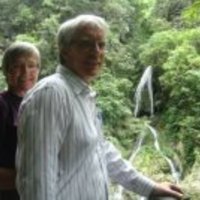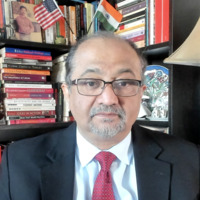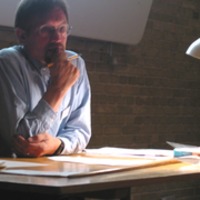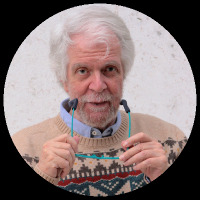Academic Papers by Tony Waters

Smartphones and ‘doing community’ in Bangkok’s platform economy: A Weberian analysis
New Media and Society, 2025
This article examines emergent communities of platform-based delivery workers in Bangkok by apply... more This article examines emergent communities of platform-based delivery workers in Bangkok by applying Max Weber’s concept of Vergemeinschaftung or ‘doing community’. Using offline and online ethnographic methods, the authors demonstrate how delivery workers do community on the streets of Bangkok and leverage smartphones and social media to extend their communities to the online realm. These community practices are culturally constituted and share characteristics with pre-existing communities in the transportation sector in Thailand. However, while these older communities are under pressure from rationalisation, or in Weber’s terms, Vergesellschaftung, rider communities emerge from the rational conditions of delivery platforms. Through this analysis, the article demonstrates how Weber’s theory effectively captures the dialectical dynamics of doing community and rationalisation in digital economies, suggesting that scholarship on digital platforms and media could benefit from adopting a Weberian analysis of social change.
https://journals.sagepub.com/doi/abs/10.1177/14614448241312653?af=R
C. Yamahata and M. Takeda (eds.), Youth, Community, and Democracy in India, Myanmar, and Thailand,, 2025
Tarticle is about why I think Burma is a victim of international politics going back to the colon... more Tarticle is about why I think Burma is a victim of international politics going back to the colonial era. Other nations have used Burma to pursue their broader interests.
Journal of the Siam Society, 2024
This short study explores detective stories by Crown Prince Vajiravudh, later King Rama VI, in ea... more This short study explores detective stories by Crown Prince Vajiravudh, later King Rama VI, in early 20th-century Siam. Compiled in Nithan Thong-in, these tales provide insights into Siamese society, culture, and history. Despite multiple reprints, an English translation is currently unavailable. This notice introduces the cultural richness of Mr Thong-in's adventures, along with brief summaries of each story.
The use of general descriptive names, registered names, trademarks, service marks, etc. in this p... more The use of general descriptive names, registered names, trademarks, service marks, etc. in this publication does not imply, even in the absence of a specific statement, that such names are exempt from the relevant protective laws and regulations and therefore free for general use. The publisher, the authors and the editors are safe to assume that the advice and information in this book are believed to be true and accurate at the date of publication. Neither the publisher nor the authors or the editors give a warranty, expressed or implied, with respect to the material contained herein or for any errors or omissions that may have been made. The publisher remains neutral with regard to jurisdictional claims in published maps and institutional affiliations.

Karen language education is still strong in the Thai-Myanmar border regions. There are currently ... more Karen language education is still strong in the Thai-Myanmar border regions. There are currently over 130,000 children being educated in Karen schools operated in Myanmar by the Karen National Union (KNU) and the Karen Refugee Council (KRC) in Thailand. These schools are taking advantage of mother tongue-based principles of literacy, which emphasize that literacy starts with the home language. Since the 1980s at least a million people have completed the basic Karen curriculum focused on Karen literacy, with many of those continuing to secondary and post-secondary education where programs are taught in Karen and English. Karen language education continues despite the marginalization of Karen schools in Myanmar since Ne Win's 1962 coup. At that time, Karen schools in the Delta Region were replaced with Burmese language schools from the Burmese Ministry of Education. Since then Karen systems of education have remained strong in border areas outside control of the government. Indeed, Karen programs may have even strengthened after many government-funded schools were shuttered following the emergence of the Civil Disobedience Movement (CDM) in 2021. Karen education is strong because, in part, it moved into Thailand, where schools continue both in refugee camps, and in migrant schools. The Karen language instruction in Thailand is typically organized by the KRC, which also provides support to schools still operated by the KNU inside Myanmar. The Karen schools in both places reflect Karen education traditions inherited from the Karen schools in Burma, which began in the 19th century. They do this while using teaching techniques and pedagogy adapted from the West, which train students to be "critical thinkers" for a Karen democracy. Development since the 1840s Karen education actually began in the 1840s with the development of modern Karen literacy, the establishment of a printing press, and the emergence of schooling. The earliest efforts were in the Irrawaddy River Delta and Rangoon (now Yangon). This led to a rapid expansion of the Karen school systems over the following decades. Karen and English language programs flourished around the large Christian mission compound in Bassein (Pathein, the capital of Ayeyarwady Region) in the Irrawaddy River Delta, as well as in Rangoon. Baptist Mission primary schools among Karen were first opened by American Baptist missionaries in 1852 at Bassein. A Karen secondary school was opened in Koesue

Social Sciences MDPI, 2023
first_pagesettingsOrder Article Reprints
Open AccessConcept Paper
Schooling, Identity, and Nation... more first_pagesettingsOrder Article Reprints
Open AccessConcept Paper
Schooling, Identity, and Nationhood: Karen Mother-Tongue-Based Education in the Thai–Burmese Border Region
by Hayso Thako 1,2,* andTony Waters 3,*ORCID
1
Department of Peace Studies, Payap University, Chiangmai 60000, Thailand
2
Karen Education and Culture Department, Mae Sot 63110, Thailand
3
Institute of Sociology and Cultural Organization, Leuphana University, 21335 Lüneburg, Germany
*
Authors to whom correspondence should be addressed.
Soc. Sci. 2023, 12(3), 163; https://doi.org/10.3390/socsci12030163 (registering DOI)
Received: 28 January 2023 / Revised: 22 February 2023 / Accepted: 27 February 2023 / Published: 9 March 2023
(This article belongs to the Section International Migration)
Download Review Reports Versions Notes
Abstract
Modern Karen education began in the early 1800s when introduced by British and American missionaries at roughly the time the British colonial powers arrived from India. After independence from Great Britain in 1948, Burma faced revolt from ethnic groups including the Karen, in large part, over issues of language and cultural self-rule. This led to the forcible closing of Karen-language schools by the military junta beginning in the 1960s and the re-establishment of Karen schooling by the Karen National Union (KNU) in independent self-rule territories, often near the Thai border. In this context, beginning in the 1980s, Karen-medium language spread into the highlands of Burma and into Thai refugee camps where Karen had been living for nearly four decades. Karen medium education is an important element establishing what Benedict Anderson called the “imagined community”. With mass Karen literacy, a national consciousness emerged, particularly in areas where schools were sustained. This separate consciousness is at the heart of the Karen of Kawthoolei. The Karen Education and Culture Department (KECD) was established in 1947 by the KNU. Karen schools provide mother-tongue-based education. Much of the development of the Karen medium curricula was undertaken by the KECD, and it is significantly different from that of the Burmese government’s curriculum, particularly in terms of language medium, literature, and history. Karen schooling reflects the Karen political consciousness, which will be at the heart of any peace agreements negotiated in the still-ongoing Burmese Civil War.
Keywords: schooling; identity; nationhood; Karen ethnicity; Burma; Myanmar; mother-tongue-based education; Thai–Burmese border; imagined communities; school administration
Journal of Research for International Educators, 2023

Social Sciences
Abstract: This article explores technical and socio-political factors that impacted construction ... more Abstract: This article explores technical and socio-political factors that impacted construction of the Gokteik Viaduct railway bridge in Shan State, Burma, and the recurring failure of political powers to complete a continuous railway between Rangoon (Yangon) and Yunnan. Under rather contentious circumstances, the British government awarded an American steel company with the contract to construct what would become the world’s longest railway trestle bridge at the time of its completion in 1900. As an engineering marvel of its era, the Gokteik Viaduct is in the same category as the Eiffel Tower in Paris. Until now, however, scarce research has explored the Gokteik Viaduct in terms of historicity and factors that ultimately prevented this structure from fulfilling its intended purpose
of transporting trainloads of marketable goods between Burma and Yunnan. This raises an ironic question: How could engineers construct such a remarkable bridge to service a railway that was
never finished? Furthermore, why does the Gokteik Viaduct largely remain unexamined in terms of its noteworthy place in the geopolitics of Southeast Asia? In answering such questions, the authors conclude that the “unseen” story of the Gokteik Viaduct is not only about engineering prowess but of a political and social environment that continues to bedevil massive infrastructure projects in Upper Burma today

Humanities and Social Sciences Communication, 2022
wrote Farang Sakdina in 1957-1958 as both a theoretical critique of western development planners,... more wrote Farang Sakdina in 1957-1958 as both a theoretical critique of western development planners, and the Marxist critics of Thai society like Jit Phoumisak. Kukrit's critique was that both used only European examples to prescribe development policies for Thailand. By this he meant that the Americans insisted on modernization theory, and Soviet theoreticians insisted on Marx's historical materialism. Kukrit responded that data developed from Europe is not applicable to Thailand because European feudalism had different attitudes toward land and labor than the ancient Thai "feudalism" known as sakdina. A textual analysis of Kukrit's book Farang Sakdina reveals Kukrit proposes a dialectical theory of historical change in which the "contradictions" within society are continually resolved and reconstituted. Kukrit uses this data to analyze politics and kingship in England, Thailand, and implicitly, other countries.

Humanities and Social Science Studies, 2022
The cultural integration of international students in Thai Higher Education (Thai HE) is spurred ... more The cultural integration of international students in Thai Higher Education (Thai HE) is spurred by a government initiative known as Thailand 4.0, and has raised the educational bar. It is a lucrative move; increased university costs and access to home countries' courses ensure capable international students now seek affordable degree education in Thailand. Thus, in this paper, we offer empirical findings based on a case study drawn across a longitudinal, year-long investigation. Using examples from a mixed-methods approach, we report a 'cultural mosaic' of multiculturalism resistant to cultural assimilation in our setting, which contrasts themes in Thai HE policy. This policy often embraces nationalist themes, found embedded in General Education (GE) courses and the habitus of Thai HE, which impacts the potential to integrate overseas students effectively into Thai culture and society. With this in mind, we question the nature of multiculturalism in the classroom, suggesting a changing phenomenon with implications for Thai HE's future. Meanwhile, we use this paper to establish the validity of tools needed for critical discussion about learning culture across the Thai HE community as we move towards Thailand 4.0. We aim to describe the cultural integration of a growing base of international students, hoping to inform the development of Thai HE, which could be a world-class and leading platform for education.

Humanities and Social Science Communications, 2022
Thai Higher Education (Thai HE) is changing, due to international reform. This paper presents dat... more Thai Higher Education (Thai HE) is changing, due to international reform. This paper presents data collected in a longitudinal study carried out in Thailand during 2017-2018 using the US version of the National Survey of Student Engagement (NSSE) and qualitative interviews. We offer a case study about the cultures and engagement of three groups of students found at an international private university in Thailand. The groups studied were international students, Chinese students in a mixed Thai/English curriculum and Thai students studying in Thai, all situated in a Thai HE institutional community. The (NSSE) was administered to 179 students: 89 in an International College, 54 Chinese students and 36 Thai students, as a control. Our results showed different attitudes toward studying, teachers, memorisation, participation, critical thinking, and empathy. This paper concludes with a discussion of how students in an international university in Thailand arrange themselves socially, and why this matters.
Asian Journal of Peacebuilding, 2021
We re-evaluate Burmese history from the perspective of Thai philosopher Prawase Wasi who asserts ... more We re-evaluate Burmese history from the perspective of Thai philosopher Prawase Wasi who asserts that the basis for society is not simply individuals but the "selfforming group. " He discusses the essential nature of a self-forming group which is embodied in the Thai Buddhist concept of taam, which are sacred virtues emerging from self-organizing groups. In between the taam and self-forming groups are institutions of the state, economy, and education, etc. Prawase Wasi's approach has been used in Thailand to guide government policies for the last twenty years. In this article, we apply this model to the history of conflict in Burma. We contrast this approach with the more traditional focus on individualism and utilitarianism in western high modernism which typically shapes development policies.

Journal of the Siam Society, 2019
Rong Wongsawan (1932-2009) was a major Thai writer during the late 20th century. He wrote primari... more Rong Wongsawan (1932-2009) was a major Thai writer during the late 20th century. He wrote primarily about social life in his native Thailand, but one of his favorite subjects was California where he lived, wrote, and bartended in the 1960s. The story presented here is about his trip to California in 1976 to show his new wife Malee where he had spent so many happy years. Published in Thai in 1978, On the Back of the Dog is a description of how a Thai writer viewed California of that era. As he points out early in the book, behind his observations are questions: Why are the Americans the way they are? Why are issues such as father-son relationships so rancorous, race relations so poisonous, attitudes toward money so greed-focused, and advertising so preposterous, especially for Thai sensibilities? Thus, in writing about San Francisco in particular, Rong is also writing about Thai culture. This article introduces Rong Wongsawan's writing to an English-speaking audience. Rong spoke idiomatic English and was well versed in American literature. However, Rong's own writing was almost completely in Thai and addressed only a Thai audience. Yet, he highlights issues of American culture and society which are of enduring interest. Presented in this article are extended translations of his writing from On the Back of the Dog, including vignettes involving a chicken executive, the tensions between white and black, actor Peter Fonda, and even Jack London's views of the great San Francisco earthquake. President Kennedy and Linda Lovelace make appearances, too. The issues Rong raises are understood in the context of Thai Buddhism and karma, Thai views of family and race. Rong Wongsawan (young man!) was an important Thai writer from the second half of the 20th century. 1 His published work began in the 1950s, with a photo-essay of the people living in Bangkok's garbage dumps, and continued until his death in 2009. Through it all, he signed his name as "young man!" in the belief that he had stopped aging at age twenty-eight. As with all great writers, Rong's work dealt with the human condition as he 1 There are few English language sources about Rong Wongsawan's life, except for an obituary in The Guardian newspaper in 2009, and an analysis of his early book Soi sanim (Unwilling to Endure) in Janit Feangfu's (2011) PhD dissertation. While Rong used this English spelling for his surname, his family now prefers Wong-Savun.

Social Sciences, 2019
This paper explores empirically Edward T. Hall's assertion about the role of musical elements, in... more This paper explores empirically Edward T. Hall's assertion about the role of musical elements, including rhythm recognition and what are called "ear worms" in popular culture. To test Hall's assertion, data were collected from the United States, Germany, Tanzania, and Thailand in 2015-2017 using a 26 brief "song intros." Data were also collected from exchange students from South Korea and Turkey. Survey responses were analyzed using factor analysis in order to identify patterns of recognition. It was found that there were indeed patterns of recognition apparently reflecting national boundaries for some song recognition, but others crossed boundaries. A separate analysis of patterned recognition comparing American youth under thirty, with elders over 60 indicated that there were also boundaries between age groups. Such experiments in music recognition are an e↵ective methodology for Culture Studies given that musical elements are tied to issues of identity, culture, and even politics. Music recognition can be used to measure elements of such subconscious habitus.
Payap University Research Report, 2019
This research describes the research undertaken about the three different national groups o... more This research describes the research undertaken about the three different national groups of students at Payap University. The three groups were students in the English curriculum International College, Chinese students from PR China, and local Thai students in the Thai curriculum. They were surveyed in order to understand their demographics, friendship patters, student engagement, Self-assessment of language skills, Long-term Plans, and Culture and Individualism. Used were a combination of quantitative and qualitative survey instruments. The data collected was evaluated for both its relevance to broader understandings of students in a multi-cultural/national learning environment, and for policy relevant conclusions.
The Mla Bri of Thailand are thought of as being recently settled hunter-gatherers. They lived in... more The Mla Bri of Thailand are thought of as being recently settled hunter-gatherers. They lived in the forests of northern Thailand until the late twentieth century, but have settled into four separate communities since that time. This paper describes the demographics of one these groups since the late 1990s based on census data from 2013, and mortality records since settlement.
In Weber's sociology of social stratification, it is important to separate questions of honor fro... more In Weber's sociology of social stratification, it is important to separate questions of honor from economics. The common term "socio-economic status" conflates the two, making it an imprecise measure.
This is a pre-publication version of an article in the 2nd edition of the Blackwell Encyclopedia ... more This is a pre-publication version of an article in the 2nd edition of the Blackwell Encyclopedia of Sociology, 2nd edition. Discussed is the uage of the words Gemeinschaft and Gesellschaft in both German and English translations of the writings of Ferdinand Toennies, and Max Weber. Gemeinschaft refers to affective associations rooted in emotions, while Gesellschaft refers to rationalized relationships mediated by the marketplace and other rationalized institutions.
Encyclopedia of Food and Agricultural Ethics, 2013
This essay is about how ethics were defined in the context of great empires, and in the modern wo... more This essay is about how ethics were defined in the context of great empires, and in the modern world. As such, it is what Polanyi called "The Great Transformation," and has themes adapted from my book The Persistence of Subsistence Agriculture, Life Beneath the Level of the Marketplace.











Uploads
Academic Papers by Tony Waters
https://journals.sagepub.com/doi/abs/10.1177/14614448241312653?af=R
Open AccessConcept Paper
Schooling, Identity, and Nationhood: Karen Mother-Tongue-Based Education in the Thai–Burmese Border Region
by Hayso Thako 1,2,* andTony Waters 3,*ORCID
1
Department of Peace Studies, Payap University, Chiangmai 60000, Thailand
2
Karen Education and Culture Department, Mae Sot 63110, Thailand
3
Institute of Sociology and Cultural Organization, Leuphana University, 21335 Lüneburg, Germany
*
Authors to whom correspondence should be addressed.
Soc. Sci. 2023, 12(3), 163; https://doi.org/10.3390/socsci12030163 (registering DOI)
Received: 28 January 2023 / Revised: 22 February 2023 / Accepted: 27 February 2023 / Published: 9 March 2023
(This article belongs to the Section International Migration)
Download Review Reports Versions Notes
Abstract
Modern Karen education began in the early 1800s when introduced by British and American missionaries at roughly the time the British colonial powers arrived from India. After independence from Great Britain in 1948, Burma faced revolt from ethnic groups including the Karen, in large part, over issues of language and cultural self-rule. This led to the forcible closing of Karen-language schools by the military junta beginning in the 1960s and the re-establishment of Karen schooling by the Karen National Union (KNU) in independent self-rule territories, often near the Thai border. In this context, beginning in the 1980s, Karen-medium language spread into the highlands of Burma and into Thai refugee camps where Karen had been living for nearly four decades. Karen medium education is an important element establishing what Benedict Anderson called the “imagined community”. With mass Karen literacy, a national consciousness emerged, particularly in areas where schools were sustained. This separate consciousness is at the heart of the Karen of Kawthoolei. The Karen Education and Culture Department (KECD) was established in 1947 by the KNU. Karen schools provide mother-tongue-based education. Much of the development of the Karen medium curricula was undertaken by the KECD, and it is significantly different from that of the Burmese government’s curriculum, particularly in terms of language medium, literature, and history. Karen schooling reflects the Karen political consciousness, which will be at the heart of any peace agreements negotiated in the still-ongoing Burmese Civil War.
Keywords: schooling; identity; nationhood; Karen ethnicity; Burma; Myanmar; mother-tongue-based education; Thai–Burmese border; imagined communities; school administration
of transporting trainloads of marketable goods between Burma and Yunnan. This raises an ironic question: How could engineers construct such a remarkable bridge to service a railway that was
never finished? Furthermore, why does the Gokteik Viaduct largely remain unexamined in terms of its noteworthy place in the geopolitics of Southeast Asia? In answering such questions, the authors conclude that the “unseen” story of the Gokteik Viaduct is not only about engineering prowess but of a political and social environment that continues to bedevil massive infrastructure projects in Upper Burma today
https://journals.sagepub.com/doi/abs/10.1177/14614448241312653?af=R
Open AccessConcept Paper
Schooling, Identity, and Nationhood: Karen Mother-Tongue-Based Education in the Thai–Burmese Border Region
by Hayso Thako 1,2,* andTony Waters 3,*ORCID
1
Department of Peace Studies, Payap University, Chiangmai 60000, Thailand
2
Karen Education and Culture Department, Mae Sot 63110, Thailand
3
Institute of Sociology and Cultural Organization, Leuphana University, 21335 Lüneburg, Germany
*
Authors to whom correspondence should be addressed.
Soc. Sci. 2023, 12(3), 163; https://doi.org/10.3390/socsci12030163 (registering DOI)
Received: 28 January 2023 / Revised: 22 February 2023 / Accepted: 27 February 2023 / Published: 9 March 2023
(This article belongs to the Section International Migration)
Download Review Reports Versions Notes
Abstract
Modern Karen education began in the early 1800s when introduced by British and American missionaries at roughly the time the British colonial powers arrived from India. After independence from Great Britain in 1948, Burma faced revolt from ethnic groups including the Karen, in large part, over issues of language and cultural self-rule. This led to the forcible closing of Karen-language schools by the military junta beginning in the 1960s and the re-establishment of Karen schooling by the Karen National Union (KNU) in independent self-rule territories, often near the Thai border. In this context, beginning in the 1980s, Karen-medium language spread into the highlands of Burma and into Thai refugee camps where Karen had been living for nearly four decades. Karen medium education is an important element establishing what Benedict Anderson called the “imagined community”. With mass Karen literacy, a national consciousness emerged, particularly in areas where schools were sustained. This separate consciousness is at the heart of the Karen of Kawthoolei. The Karen Education and Culture Department (KECD) was established in 1947 by the KNU. Karen schools provide mother-tongue-based education. Much of the development of the Karen medium curricula was undertaken by the KECD, and it is significantly different from that of the Burmese government’s curriculum, particularly in terms of language medium, literature, and history. Karen schooling reflects the Karen political consciousness, which will be at the heart of any peace agreements negotiated in the still-ongoing Burmese Civil War.
Keywords: schooling; identity; nationhood; Karen ethnicity; Burma; Myanmar; mother-tongue-based education; Thai–Burmese border; imagined communities; school administration
of transporting trainloads of marketable goods between Burma and Yunnan. This raises an ironic question: How could engineers construct such a remarkable bridge to service a railway that was
never finished? Furthermore, why does the Gokteik Viaduct largely remain unexamined in terms of its noteworthy place in the geopolitics of Southeast Asia? In answering such questions, the authors conclude that the “unseen” story of the Gokteik Viaduct is not only about engineering prowess but of a political and social environment that continues to bedevil massive infrastructure projects in Upper Burma today
The problem is that by definition culture is taken for granted and typically subconscious, culture is difficult to notice. Proxies are often introduced in the form of artifacts, which is one reason why ancient “cultures” are named after marks on the pottery left behind. Other artifacts typically cited are things like architectural style, dress, food likes, musical tastes, writing systems, language use, etc. etc. The list could be endless.
But these the products of culture, are not culture itself. In this paper, I would like to talk about two ways I have been trying to answer the “what is culture?” question for some years, by returning to two very different phenomena. The first will be the subconscious musical rhythms to which groups of people (cultures?) are attuned and will rely on the Edward T. Hall’s studies of rhythms and time. To do this I will describe an experiment I did in four different countries about “attunement” (see Waters and Philhour 2019).
Then I am going to switch gears, and try something different, which is to describe how neural networks, which are biological structures in the brain, are created by cultural environments (Waters 2014). The stretch is broad, and I appreciate 15 minutes of your attention to explain how these two very different things might be reflecting an underlying substrate that is “culture.”
In order to evaluate the linguistic resources, 179 students at Payap university were asked to do a Common European Framework of Reference for Languages (CEFR), which is an international standard for evaluating language abilities. This survey tool was translated from English into both Chinese and Thai. English-speaking, Chinese, and Thai students evaluated themselves across five oral and written categories. This paper is a preliminary report on what we are learning about the varied language skills that Payap students bring to the Thai, International, and Chinese language programs.
The preliminary results described here indicate varied competencies in a variety of “spoken production” skills in various languages. This data will be used to evaluate Payap University’s own programs, as well as make comparisons with other Thai universities, and globally.
Note also, this book is a critique of "evidence based research," a popular subject not just in prisons, but throughout public administration.
https://www.amazon.com/Prison-Vocational-Education-Policy-United/dp/1137564687/ref=sr_1_1?ie=UTF8&qid=1470925188&sr=8-1&keywords=Vocational+Education+in++Prisons
Our point in translating these essays was to use 21st century English, while highlighting Weber's wisdom, wit, insight, and humor. The book is available from Palgrave MacMillan http://www.palgrave.com/page/detail/webers-rationalism-and-modern-society-tony-waters/?K=9781137365866 The book is edited and translated by Tony Waters and Dagmar Waters.
This version of this article was written for the Lutheran World Federation where I was Program Officer at the time. A revised version was published in "Human Organizationzzz' in 1999 under a different title. This version is found in the Refugee Studies Center in Oxford as "grey literature." In this context it has been cited in the academic literature a couple of times.
Economists, politicians, and strategists since at least the end of World War II dream of the world's rural farmers becoming a wealthy, healthy, and modern middle class. Implicit to this dream is peasants moving off the farms of China, India, Africa, and Latin America to staff factories in an ever-wealthier world. When this doesn't happen, the Ph.D.s do indeed sigh, sweat, and swear not at themselves, but at the peasants that frustrate the models on which their development plans are based.
I started this paper for a socioloogy class in 1991, and presented it at a conference in 1992. An editor from the Journal of Quantitative Anthropology approached me about publishing it, and it was accepted after peer review. Somehow, though, it never made it into print--I think when I abandoned in in 1995 or so it had to do with being sure that the centrality statistics were accurately coded.
Anyway, I found this copy recently on the internet--I don't know who put it up. Reading it over, though, I am actually quite proud of the article--it offers a unique take I think, on gender and sexuality among a chimpanzee community in Tanzania. I may pursue this subject again someday--but in the meantime, here is the 1995 version.